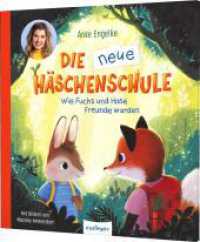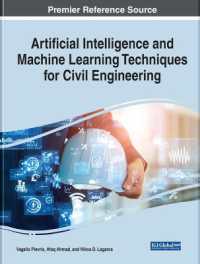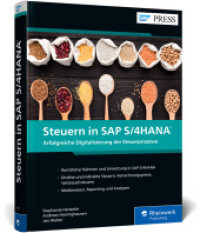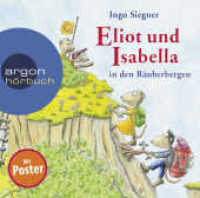- ホーム
- > 洋書
- > ドイツ書
- > Mathematics, Sciences & Technology
- > Earth Science
- > geography
Description
(Table of content)
From the contents:
Andrew Goudie, President International Association of Geomorphologists: Foreword 4
Mario Panizza, Former President International Association of Geomorphologists: Preface 4
Emmanuel Reynard, Paolo Coratza and Géraldine Regolini-Bissig: Scientific research on geomorphosites over the last eight years: improvements and aims of the book 5-8
Section I - What are geomorphosites?
1. Emmanuel Reynard: Geomorphosites: definitions and characteristics 9-20
2. Emmanuel Reynard: Geomorphosites and landscapes 21-34
3. Mario Panizza and Sandra Piacente: Cultural geomorphology and geodiversity 35-48
4. Enrique Serrano and Purificacion Ruiz-Flano: Geomorphosites and geodiversity 49-61
Section II - Assessment and mapping
5. Emmanuel Reynard: The assessment of geomorphosites 63-71
6. Viola Maria Bruschi and Antonio Cendrero: Direct and parametric methods for the assessment of geosites and geomorphosites 73-88
(Text)
Geoheritage that are the geological and geomorphological elements of nature worthy of being conserved is an important component of the natural heritage. In most cases, it constitutes the skeleton of the landscape. The new interest of the scientific community for the geomorphological heritage the so-called geomorphosites has induced the International Association of Geomorphologists (IAG) to create in September 2001, at the 5th International Conference on Geomorphology held in Tokyo, a specific working group aiming to improve knowledge and scientific research on the definition, assessment, cartography, promotion and conservation of geomorphosites. During the last eight years, experiences were shared during workshops and international conferences and the main results were published in international journals. This book proposes a synthesis of the research on the geomorphological heritage, both at the conceptual and methodological level. The results presented here are based on numerous studies carried out by various researchers in different contexts (academic research, environmental impact assessment, conservation, geotourism) and countries. This book, written by a first class international team, will help researchers and students dealing with geotourism, geodiversity, geoconservation and geoparks in their tasks.








